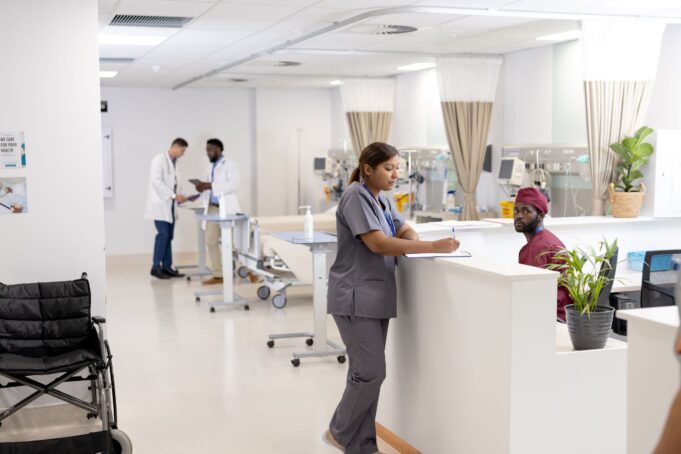Amidst rising healthcare demands and shifting workforce dynamics, hospital facilities face the critical task of managing their workforce effectively. This involves optimizing staff performance, enhancing patient care, and maintaining organizational sustainability. The challenges are significant: staffing shortages, burnout, and escalating labor costs are pressuring healthcare institutions, impacting not only the professionals who provide care but also the quality of patient experiences. Addressing these issues through strategic workforce management and innovative facilities practices is essential for creating a resilient and adaptable healthcare environment that meets the evolving needs of both patients and staff.
Importance of Workforce Management in Hospital Facilities
Effective workforce management in hospital facilities is essential for both patient care and operational efficiency. Here are key points highlighting the importance and challenges of managing healthcare staff:
- Crucial for High-Quality Care: Ensures that hospitals maintain high standards in patient care and operational efficiency.
- Increasing Demands: The growing demands on healthcare systems make effective staff management and training more critical.
- Current Challenges:
- Staffing Shortages: A widespread shortage of healthcare professionals.
- Employee Burnout: High levels of burnout among staff impact their well-being and performance.
- Rising Labor Costs: Escalating costs add financial strain to healthcare organizations.
- Impact on Patient Experience: These challenges directly affect the quality of patient care and overall patient experience.
- Strategic Workforce Management: Necessary for creating a resilient and adaptable environment that meets the evolving needs of patients and healthcare staff.
Healthcare Workforce Planning and Strategy
Strategic Workforce Planning
- Forecasting Staffing Needs and Strategic Alignment
- Effective workforce planning in hospital facilities involves accurately forecasting future staffing needs to ensure that the right number of staff with the necessary skills are available when needed. This proactive approach helps align staffing levels with the hospital’s strategic goals, such as improving patient care quality, expanding services, and maintaining financial sustainability. By anticipating changes in patient volume, regulatory requirements, and healthcare trends, hospital administrators can develop strategies to recruit, retain, and train staff to meet these demands. This alignment not only enhances operational efficiency but also supports the hospital’s long-term vision and mission.
- Optimizing Workforce Planning with Data Analytics and Technology
- The integration of data analytics and technology into workforce planning allows hospitals to make data-driven decisions that optimize staffing levels and reduce costs. Advanced analytics tools can analyze patterns in patient admissions, seasonal fluctuations, and staff turnover rates to predict staffing needs more accurately. Additionally, technology such as workforce management software can streamline scheduling, track employee performance, and identify potential staffing shortages or surpluses. By leveraging these tools, hospitals can improve workforce efficiency, reduce reliance on costly temporary staff, and enhance overall patient care.
Alternative Staffing Models
- Exploration Gig Workforce, On-Demand Staffing, and Internal Labor Pools
- In response to traditional staffing challenges, many hospitals are exploring alternative staffing models to increase flexibility and responsiveness. The gig workforce model, which involves hiring temporary or freelance healthcare professionals, allows hospitals to quickly scale their workforce based on demand. On-demand staffing platforms enable healthcare facilities to fill shifts at short notice, ensuring continuity of care even during peak times or unexpected absences. Internal labor pools, which consist of cross-trained staff members who can be deployed across various departments, provide an additional layer of flexibility and support.
- Benefits of Flexible Staffing Solutions and Real-Time Scheduling
- Flexible staffing solutions, such as the use of on-demand staffing platforms and internal labor pools, offer several benefits for hospital facilities. These models provide a buffer against sudden fluctuations in patient volume, reduce the risk of employee burnout by distributing workload more evenly, and allow for better management of labor costs. Real-time scheduling capabilities enable hospitals to respond quickly to changes in staffing needs, minimize downtime, and ensure that the right staff are in place to meet patient care requirements. This adaptability not only improves operational efficiency but also enhances the overall work environment for healthcare professionals.
Employee Well-being and Retention
Addressing Burnout and Retention
- Impact of Burnout on Staff Retention and Patient Care Quality
- Burnout among healthcare staff is a significant factor contributing to high turnover rates and compromised patient care quality. When healthcare professionals experience physical and emotional exhaustion, it diminishes their ability to provide attentive and compassionate care, leading to decreased patient satisfaction and potentially adverse outcomes. Burnout also increases the likelihood of staff leaving their positions, which exacerbates staffing shortages and places additional strain on remaining employees, creating a cycle of stress and reduced performance.
- Strategies for Creating a Supportive Work Environment
- To mitigate burnout and improve retention, healthcare facilities must create a supportive work environment. Key strategies include implementing flexible work arrangements that allow staff to balance their professional and personal lives, thereby reducing stress and burnout. Additionally, fostering a culture of engagement through regular communication, recognition programs, and professional development opportunities helps employees feel valued and connected to their workplace. Employee engagement programs, such as wellness initiatives and team-building activities, can also enhance morale and foster a sense of community, further supporting retention efforts.
Comprehensive Training and Development
- Continuous Education’s Impact on Staff Retention and Performance
- Continuous education and training are crucial for maintaining a skilled and competent workforce in healthcare settings. Providing ongoing learning opportunities not only enhances staff skills and knowledge but also contributes to job satisfaction and career development. Employees who feel supported in their professional growth are more likely to remain with their employer, reducing turnover rates. Additionally, well-trained staff are better equipped to handle the complexities of patient care, leading to improved performance and patient outcomes.
- Importance of Technology in Accessible, Tailored Training
- The integration of technology in training programs allows healthcare facilities to deliver education that is both accessible and tailored to individual needs. Online learning platforms, virtual simulations, and mobile training applications provide flexible and convenient options for staff to engage in professional development at their own pace. This approach is particularly beneficial in a 24/7 healthcare environment, where traditional classroom-based training may not be feasible. Furthermore, technology enables the customization of training content to address specific skill gaps and competencies, ensuring that training is relevant and impactful.
Facilities Management and Workplace Well-being
Role of Facilities Management in Employee Well-being
- Integrating Biophilic Design, Sensory Comfort, and Flexible Spaces for Well-being
- Facilities management plays a critical role in creating environments that promote well-being by incorporating elements of biophilic design, such as natural lighting, greenery, and water features. Sensory comfort can be further enhanced through careful control of noise levels, air quality, and temperature. Flexible spaces that allow for both collaboration and solitude can cater to the diverse needs of employees, helping to reduce stress and improve focus. These design elements not only boost morale but also contribute to a healthier, more productive workplace.
- Impact of Physical Work Environment on Employee Health
- The physical work environment significantly affects employees’ mental and physical health. Poor lighting, inadequate ventilation, and uncomfortable seating can lead to physical ailments such as eye strain, respiratory issues, and musculoskeletal disorders. Additionally, a poorly designed environment can contribute to mental fatigue and increased stress levels. By prioritizing the physical comfort of employees, facilities management can help mitigate these health risks, leading to a more engaged and satisfied workforce.
Technological Integration in Facilities Management
- IoT and AI Technologies for Environmental Monitoring
- The integration of Internet of Things (IoT) devices and AI-driven technologies allows facilities managers to monitor real-time data on air quality, lighting, temperature, and humidity levels. These technologies can automatically adjust environmental conditions to maintain optimal comfort and safety, enhancing the overall well-being of employees. For example, AI can predict when spaces are most likely to be occupied and adjust lighting and temperature accordingly, ensuring a comfortable environment without unnecessary energy expenditure.
- Adopting Energy-efficient Solutions and Advanced Management Tools
- Energy-efficient solutions, such as LED lighting and advanced HVAC systems, not only reduce operational costs but also improve the environmental quality within facilities. These systems can be integrated with smart building management tools that provide detailed analytics and insights, enabling proactive maintenance and efficient resource allocation. By adopting these technologies, facilities management can create a more sustainable workplace, enhance employee comfort, and contribute to broader environmental goals.
Actionable Strategies for Success
- Implement Data-Driven Workforce Planning
- Utilize advanced data analytics and technology to forecast staffing needs accurately. This approach helps hospitals align their workforce with patient care demands, reduce reliance on temporary staff, and manage labor costs effectively. By integrating predictive analytics, facilities can anticipate seasonal patient volume changes and staff turnover, ensuring optimal staffing levels at all times.
- Adopt Flexible Staffing Models
- Explore alternative staffing solutions such as gig workforce, on-demand staffing platforms, and internal labor pools. These models offer flexibility and responsiveness, allowing hospitals to quickly adapt to fluctuating patient volumes and unexpected staff absences. Real-time scheduling tools can help distribute workload evenly, reduce burnout, and maintain a positive work environment, ultimately improving patient care and staff retention.
- Enhance Facilities Management for Employee Well-being
- Focus on creating a supportive physical work environment through the integration of biophilic design, sensory comfort, and flexible spaces. Incorporate technologies like IoT and AI for monitoring and optimizing environmental conditions, such as air quality and lighting. Implementing energy-efficient solutions not only reduces operational costs but also enhances the overall workplace atmosphere, contributing to the mental and physical well-being of healthcare staff.
Integrated workforce and facilities management strategies play a vital role in the smooth operation and sustainability of hospital facilities. Addressing challenges like staffing shortages, high turnover, and compliance with regulations helps optimize the workforce, boost employee satisfaction, and improve patient care. As the healthcare landscape evolves, so must the strategies used to manage these facilities, with a focus on innovation and adaptation.
Investment in technology and employee well-being will be increasingly important for hospital facilities. Advanced workforce management systems, improved workplace environments, and comprehensive training and development programs can all contribute to a more efficient and supportive healthcare setting. Hospital facilities management professionals should prioritize these comprehensive strategies to create a resilient and adaptable environment. This proactive approach not only enhances operational efficiency but also fosters a thriving healthcare community that benefits both employees and patients.






